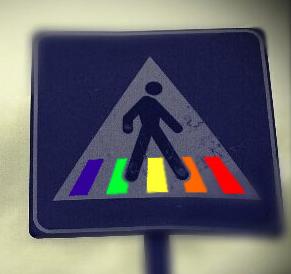Intro
Phia Bennin and Brendan McMullan describe how they came across an experiment from a previous show and decided to try it out themselves. Together, they take us through their experiment, known as a color walk.

Color Walking | Color walks were created for people to draw inspiration from the world, and colors, around them.
What is a color walk?
Originally created as a tool to inspire his students, color walks were dreamed up by William Burroughs. Students were told to take a walk and focus on the colors they see.
How does a color walk work?
The simplicity of the idea of color walks means anyone can try it. After walking out the door, you choose a color that pops out at you and continue on a walk paying attention to your surroundings. As you continue on your walk, your eyes will follow the pops of that color from one object to the next.
Bennin and McMullan mention the decision to also allow the flexibility of switching from one color to another depending on what catches your eye. This way, it might be easier to let the colors get your attention when you find yourself searching for a pop of a certain color that is not there. “A woman’s lavender handbag might draw us to the right; a yellow cab could pull us down a side street; a green pistachio ice cream cone could shove us into the park” (RadioLab).
RadioLab’s Result
After their walk, Bennin and McMullan describe their experience. Included in the article is a timeline of their color walk. Staying true to their claim that they would switch colors naturally, their colors switch from a blue scarf and blue nails to purple and pink.
The colors that they saw on their color walk lingered in their heads and affected their perception of colors. “We walked away seeing a world brimming over with colors” (RadioLab).

NYC Street 18 | Letting your eyes catch pops of color that stands out to you will keep your color walk unrestricted and let inspiration flow.
A Few Words of Advice
They also included advice for anyone who wanted to try out going on a color walk themselves. First, they stressed the importance of allowing an hour of uninterrupted time. Not having a specific schedule, time limit, or destination allows your eyes to wander and carry your legs with them. Secondly, pick a color that stands out to you. Glancing around and letting your eyes choose a color that makes you do a double take guarantees that you won’t let the color fade out. A bland, dim color might not be as easily or inspiring to follow than an interesting shade of blue, bright orange, or clean white. Their last piece of advice is if you get lost to simply let your eyes pick another color. The unrestricted feeling that this color walk gives you means that there are no binding rules to limit your inspiration. Maybe next I walk down a street in Atlanta, I’ll let a color catch my eye.
Works Cited
Bennin, P., & McMullan, B. “Color Walking”. RadioLab. 29 June 2012.
Web:http://www.radiolab.org/story/214709-color-walk/. 5 March 2016.
Color Walking. Digital Image. Flickr. 2012. Web. 5 March 2016.
Man, Tesla. NYC Street 18. Digital Image. Wikia. 8 September 2013.
Web. 5 March 2016.